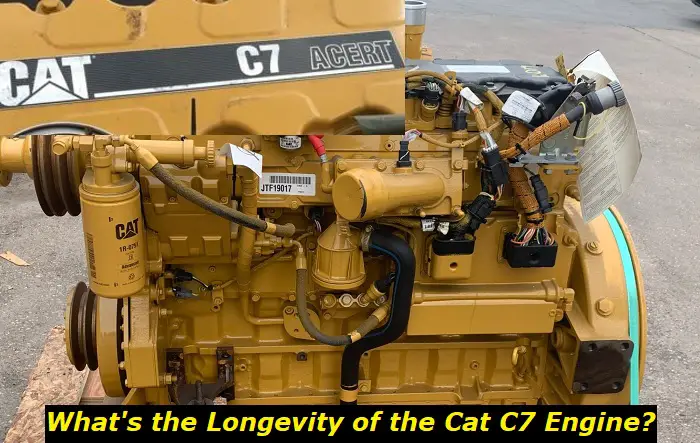Cat C7 Engine Life Expectancy: What Affects and How to Prolong?
Understanding the life expectancy of heavy machinery like the Cat C7 engine is essential for any seasoned mechanic or operator. This knowledge not only aids in keeping you prepared for necessary replacements and overhauls but could greatly save on costs and downtimes. With remarkable features such as the HEUI fuel system, 300-horsepower, and electronic control module, the Cat C7 is truly a marvel in the diesel engine fraternity.
Apart from understanding the engine's robust and high-performing components, discerning the factors that influence its lifespan is pivotal in maximizing an engine's potential. In this article, we'll look at direct influencers such as maintenance practices, usage intensity and load factors that may affect the longevity of a Cat C7 engine. We will further provide essential maintenance tips, signs of a failing engine, and present an approximate life expectancy drawing from user experiences and professional insights.

Components and Functionality of the Cat C7 Engine
Welcome under the hood of the Cat C7 engine, a paragon of gross power and reliability designed to tackle the toughest of conditions. Delve deeper and marvel at the impeccable engineering set up that harmoniously works together to deliver that unmatched performance you love.
The Cat C7 boasts advanced engine technologies aimed at improving fuel efficiency and overall performance. Take, for example, the Hydraulic Electronic Unit Injector (HEUI) fuel system. This unique feature separates the role of high-pressure oil and low-pressure fuel, leading to a better, more efficient combustion process. It propels a lower fuel dumping rate, leading to a smoother ride courtesy of fewer engine vibrations.
Built on the ACERT Technology, the engine's electronic management system provides optimized engine performance, enabling it to meet emission standards while maintaining engine durability. Its Variable Valve Timing (VVT) and series turbo-charging further enhance engine capability by ensuring better combustion control and increased power density.
Furthermore, the engine's Electronic Control Module (ECM) plays an integral part in the engine's functionality. This component closely monitors and adjusts various engine parameters like fuel injection, air intake, and exhaust levels to optimize engine performance and enhance fuel economy.
Of course, we can't forget the sturdy build, featuring the Caterpillar-created compacted graphite iron block structure - a material much stronger and lighter than the traditional cast iron. This results in a robust, high-performing engine that withstands the test of time. That, my friend, is the celebrated strength of the Cat C7 engine, a mechanical symphony playing in unison to power your heavy-duty applications.
Factors that Influence the Life Expectancy of a Cat C7 Engine
The lifespan of a Cat C7 engine is not set on stone- it's flexible and majorly dependent on a couple of crucial factors. Let's delve into these crucial elements that play pivotal roles in shaping how long one of these outstanding engines can hold up against the test of time and grueling work conditions.
First and foremost, the overall maintenance practices executed on the engine come to play. Like any other well-oiled machine, a Cat C7 engine requires regular and meticulous maintenance. This includes following the manufacturer's specified service intervals, conducting regular oil changes, as well as cleaning or replacing air and oil filters as recommended.
Up next, usage intensity cannot be overstated. How hard an engine is made to work will undeniably have a significant impact on its longevity. Continually pushing a Cat C7 to its extreme limits, especially without sufficient pauses to cool down and rejuvenate itself can prematurely wear down the engine which in turn, reduces its life expectancy.
Similarly, load factors also come into play when considering an engine's lifespan. If an engine is regularly made to haul massive loads, it's likely to wear down faster. This is because the continued strain imposed on the engine elements leads to accelerated wear and tear.
Lastly, the type of fuel used can't be overlooked. High-quality diesel can help in enhancing the engine's productivity and overall life expectancy. Using poor quality or contaminated fuel may clog your injectors thereby forcing your engine to work harder than it should.
In essence, the trick to enjoying extended service from your Cat C7 engine lies in treating it right, servicing it as per schedule, and loading it responsibly.
Typical Lifespan of a Cat C7 Engine
With its impressively engineered components, the Cat C7 engine is designed to endure extensive hours of operation under some of the most strenuous conditions. Even under such circumstances, a properly cared-for engine can offer an admirable performance over time. But the question remains: what is this engine's typical lifespan?
In the realm of heavy machinery, an engine's lifespan is typically gauged by the number of operational hours rather than miles or years as commonly seen with vehicles. For the Cat C7, its typical lifespan can considerably vary depending on its application, operational conditions, and maintenance. However, drawing from field experiences and service data, many users report that a well-maintained Cat C7 engine can clock up to a remarkable 450,000 to 550,000 miles. That could equate to approximately 10,000 to 12,000 engine hours for a medium-duty truck application on-the-road.
Yet, it's essential to remember that these figures are not absolute standards but instead provide a general ballpark. Each engine's lifespan can significantly deviate based on individual operational and maintenance factors. However, the fundamental consensus remains that a properly maintained Cat C7 engine can indeed afford a notably lengthy service life.
Maintenance Tips to Extend the Life of Your Cat C7 Engine
As a seasoned mechanic in heavy machinery, one can never overstate the importance of regular and proactive maintenance in extending the life of your machine. When it comes to the Cat C7 engine, a few vital practices can go a long way in ensuring its longevity.
The first crucial practice is consistent fluid checks. Regularly checking and changing the engine's oil is one of the primary ways to keep your Cat C7 engine running smoothly. Using the right type of oil that is indicated in the manufacturer's guide cannot be stressed enough, and it's equally important to occasionally check the engine coolant levels.
Secondly, the fuel injectors in your Cat C7 engine play a key role. It is imperative to ensure that they aren't clogged and are functioning at optimal levels. A fault in the fuel injectors could lead to poor fuel economy, a decrease in power, and eventually, a deteriorating engine performance.
It's important to note, while the engine filter can often be overlooked during maintenance checks, it is of utmost pertinence to the Cat C7. It's beneficial to routinely replace the engine filter to maintain the overall engine performance and prevent any premature wears.
Additionally, regular visual inspections of your engine can be incredibly informative. This encompasses looking out for any leaks, inspecting the engine's belts for wear and tear, and checking for any abnormal sounds. An unusual noise might be indicative of a problem that needs immediate attention.
In conclusion, proper and routine maintenance is a small price to pay compared to the hefty cost implications of a failing engine. It's all about taking preemptive measures, spotting trouble signs early, and addressing them promptly. As a friendly reminder, always refer to your service manual for detailed maintenance procedures and recommendations tailored for your Cat C7 engine.
Warnings and Signs of a Failing Cat C7 Engine
Operating heavy machinery like the Cat C7 engine requires a keen understanding of subtle shifts in performance, abnormal noises, or symptoms that denote possible wear and tear. We cannot overstate the importance of being alert to these telltale signs as they may save you from significant repair costs or even a complete engine failure.
Engines are like complex puzzles - every component has a crucial role to play. Hence, spotting issues early often involves paying attention to the smallest of details. One of the clear indicators of a potential problem is a significant decrease in engine performance. This could manifest as sluggish acceleration, poor fuel efficiency, or a trapped feeling while driving the vehicle.
Similarly, the frequent loss of engine power, popularly known as 'engine derating', could also indicate a failing fuel system - a common concern with the Cat C7 models. Engine derating often surfaces as sudden drops in the engine's top speed or even frequent stalling. These signs cannot be ignored as they might point to a looming engine failure.
Then, we have signs like excessive smoke that suggest a problem in combustion. This could arise from multiple issues such as improper injection timing, worn-out piston rings, or a broken cylinder liner, among other things. Remember, a healthy Cat C7 engine should burn fuel completely, leaving little to no visible smoke. So, when you see any unusual smoke, it's a clear nudge to check on the health of your engine.
Finally, an important warning signal is abnormal engine noise, such as knocking or popping. These sounds are usually a sign of mechanical problems within the engine, which can lead to severe engine damages if not attended urgently. Regular inspection of the wear and tear on internal parts can help you catch these issues early, preventing a significant breakdown.
While these signs might seem daunting, gaining a firm understanding of them can let you take preventive measures. In the long run, these steps ensure that your Cat C7 continues to perform at its peak, thereby extending its lifespan.

Add comment